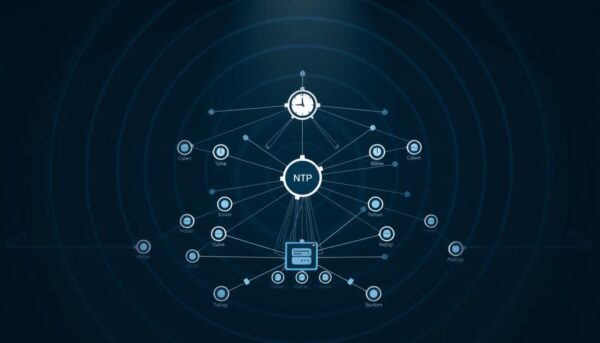Imagine your security logs show a breach at 9:00 AM. Another device flags suspicious activity at 8:59 AM. Are these events connected—or just a coincidence caused by mismatched clocks? Time synchronization isn’t just about keeping schedules—it’s the invisible glue holding your network’s reliability together.
Every transaction, login attempt, and system alert relies on precise timing. Without it, authentication fails, logs become useless, and critical data slips through the cracks. This is where the Network Time Protocol shines—a behind-the-scenes hero ensuring every device ticks in unison.
Developed in the 1980s, this protocol now powers everything from financial trades to global server networks. It’s why your emails timestamp correctly and why systems worldwide agree on what “now” means. But how does it achieve millisecond accuracy across continents? And what happens when clocks drift even slightly?
Key Takeaways
- Accurate timekeeping prevents security gaps and keeps logs reliable
- The protocol uses a hierarchy of servers for precision
- Modern networks achieve millisecond synchronization
- Configuration errors can lead to authentication failures
- UDP port 123 is critical for time data flow
- Multiple servers provide backup and accuracy checks
Understanding NTP and Its Importance
Ever received an email timestamped before you hit “send”? That’s what happens when devices disagree on what time it is. Clocks drifting apart by seconds can scramble log files, break authentication systems, and even invalidate financial transactions.
What Is Network Time Protocol?
This internet standard syncs computer clocks using a hierarchy of servers. Developed in the 1980s, it maintains accuracy within milliseconds across global networks. The protocol constantly adjusts for delays, ensuring your devices agree whether it’s 9:00:00 or 9:00:01.
Why Your Network Can’t Survive Without Sync
Security systems check login attempts in sequence. Database backups timestamp transactions. When clocks disagree:
- Firewalls might block valid requests
- Fraud detection systems miss patterns
- Server crashes become untraceable
Choosing Between NTP and Its Simpler Cousin
| Feature | NTP | SNTP |
|---|---|---|
| Accuracy | ±1 millisecond | ±100 milliseconds |
| Use Case | Banks, telecoms | IoT devices |
| Error Correction | Advanced algorithms | Basic adjustments |
SNTP works for devices where precise timing isn’t critical. But for networks handling sensitive data? Full implementation matters.
How NTP Works: Core Concepts and Architecture
Have you ever wondered how your devices stay perfectly in sync across continents? The answer lies in a pyramid-like structure where time trickles down from ultra-precise sources to your local devices.

Stratum Levels and Hierarchy
Think of stratum levels as a relay race for accurate timing. At the top (stratum 0), atomic clocks and GPS receivers define “true time.” These connect to stratum 1 servers—the primary distributors. From there, stratum 2 servers collect updates, then pass them to stratum 3 devices like your office router.
Each jump adds minuscule delays—usually under 10 milliseconds. The protocol uses smart algorithms to filter out network hiccups. It cross-checks multiple sources, discarding any that show inconsistencies.
Reference Clocks and Time Sources
Authoritative time sources anchor the entire system. Beyond atomic clocks, radio receivers tuning to WWV broadcasts and GPS satellites feed data into stratum 0 devices. These form the foundation for network protocols that demand split-second coordination.
By 1999, over 300 public stratum 1 servers supported 175,000+ devices worldwide. Today’s networks use redundant sources—if one server drifts, others compensate automatically. “The hierarchy isn’t just about accuracy,” notes a network engineer. “It’s about creating a self-healing web that adapts to outages and errors.”
This design lets your systems maintain sync for days during internet disruptions. Historical performance data and statistical models keep clocks aligned until connections resume.
Setting Up NTP Servers in Your Network
What happens when your backup systems timestamp files incorrectly? Or when security cameras disagree about incident timelines? Precise timekeeping starts with proper server setup. Let’s explore how to deploy reliable synchronization across your infrastructure.

Choosing the Right Protocol Version
Always use version 4 (RFC 5905) for new deployments. This standard offers better security and handles network delays smarter than older versions. While version 3 clients can sync with v4 servers, reverse compatibility needs manual tweaks.
| Feature | NTPv4 | NTPv3 |
|---|---|---|
| Security | SHA-1/MD5 auth | Basic auth |
| Compatibility | Backwards support | Limited updates |
| OS Support | Windows 10+, Linux 3.2+ | Legacy systems |
Hardware Selection Guide
Most networks use existing servers – a Linux box needs just 512MB RAM. For critical systems, consider GPS-synced appliances. These specialized devices maintain accuracy within 1 microsecond.
Cross-Platform Installation
On Ubuntu, run sudo apt install ntpd. Windows users can use Meinberg’s GUI for XP and newer. Always configure multiple upstream sources in ntp.conf – four is ideal for redundancy.
Locking Down Your Setup
Enable access controls with restrict commands. Use symmetric keys instead of vulnerable Autokey authentication. “Treat time servers like domain controllers,” advises a Microsoft security engineer. “One compromised server can destabilize your entire network.”
Configuring NTP for Optimal Performance
What separates functional timekeeping from precision synchronization? The answer lies in strategic configuration choices that transform basic clock alignment into a bulletproof timing infrastructure.
Basic Configuration Steps
Start by editing your ntp.conf file. Define at least four upstream servers using server pool.ntp.org iburst lines. The iburst option accelerates initial synchronization by sending packet clusters.
Set access controls with restrict commands to block unauthorized queries. Use geoDNS to direct devices to nearby time sources automatically. This reduces latency while maintaining accuracy across distributed networks.
Advanced Configuration Options
For unstable connections, enable burst mode with burst in server definitions. This sends eight packets instead of one during polling. Adjust minpoll and maxpoll values to balance accuracy with network load:
| Setting | Default | Optimal Range |
|---|---|---|
| minpoll | 6 (64s) | 4 (16s) |
| maxpoll | 10 (1024s) | 9 (512s) |
Enable logging with logfile /var/log/ntpd.log to track synchronization health. Review drift files weekly to catch hardware clock inconsistencies early.
Synchronizing Multiple Network Devices
Configure routers first – they become time sources for downstream devices. On Cisco IOS, use ntp server 192.168.1.10. Windows clients need w32tm /config /syncfromflags:manual /manualpeerlist:"ntp1.local" in Command Prompt.
For segmented networks, deploy local stratum 2 servers in each subnet. These act as intermediaries, preventing WAN latency from affecting internal devices. Always keep UDP port 123 open in firewalls between time servers and clients.
Troubleshooting Common NTP Problems
When your network devices argue about what time it is, security alerts misfire and logs become unreliable. Even minor clock disagreements can cascade into major operational headaches. Let’s explore how to spot and fix synchronization glitches before they impact your systems.
Diagnosing Sync Issues
Start with ntpq -p to check server connections. Look for reach values of 377 (all packets received) and offsets under 100ms. High dispersion numbers near 16000 mean your clock is drifting uncontrollably.
Firewalls often block UDP port 123—test connectivity with ntpdate -q. Authentication failures? Verify matching key IDs on clients and servers. “A single mismatched key can break an entire time hierarchy,” warns a network security specialist.
Fixing Clock Drift
Hardware clocks degrade over time. If adjustments exceed 500ms, replace aging components. For persistent drift:
- Shorten poll intervals to 16 seconds
- Add GPS-synced reference clocks
- Isolate devices from temperature swings
Exclude unstable sources using server 192.0.2.1 iburst maxpoll 6 in your config. Monitor jitter—values above 10ms indicate network congestion. Regular ntpd -d tests reveal hidden latency spikes that disrupt synchronization.
Conclusion: Maintaining a Reliable Time Infrastructure
Your network’s heartbeat depends on synchronized clocks working in perfect rhythm. Consistent timekeeping requires ongoing maintenance—like checking server health and updating configurations. Build redundancy with multiple time sources to prevent single points of failure. Three geographically dispersed servers create a safety net during outages.
Monitor synchronization metrics weekly. Track offset values and packet loss rates to catch drift early. Regular audits reveal security gaps, like unpatched software or weak authentication settings. Document every layer of your time architecture, from primary servers to device-level clients.
As networks expand, plan for scalable solutions. Local stratum 2 servers keep distributed teams aligned while reducing WAN dependency. Emerging protocols like PTP handle specialized needs, but the Network Time Protocol remains the backbone for most systems.
Create a maintenance checklist: verify server responses, test backup sources, and review firewall rules for UDP port 123. These steps ensure your clocks stay accurate—down to the millisecond—keeping logs trustworthy and systems secure.